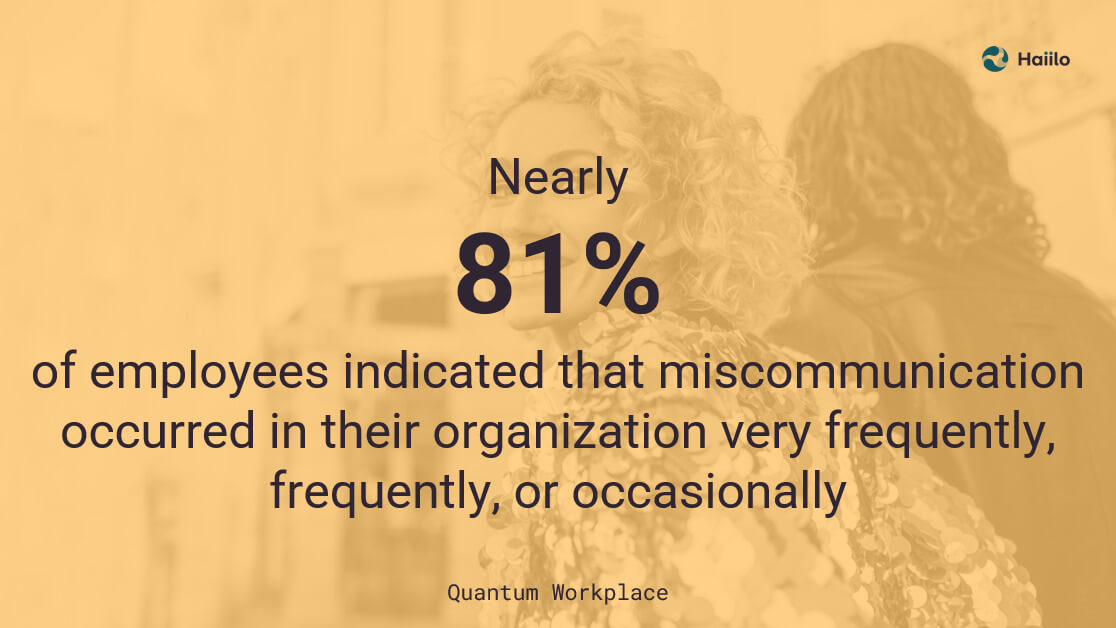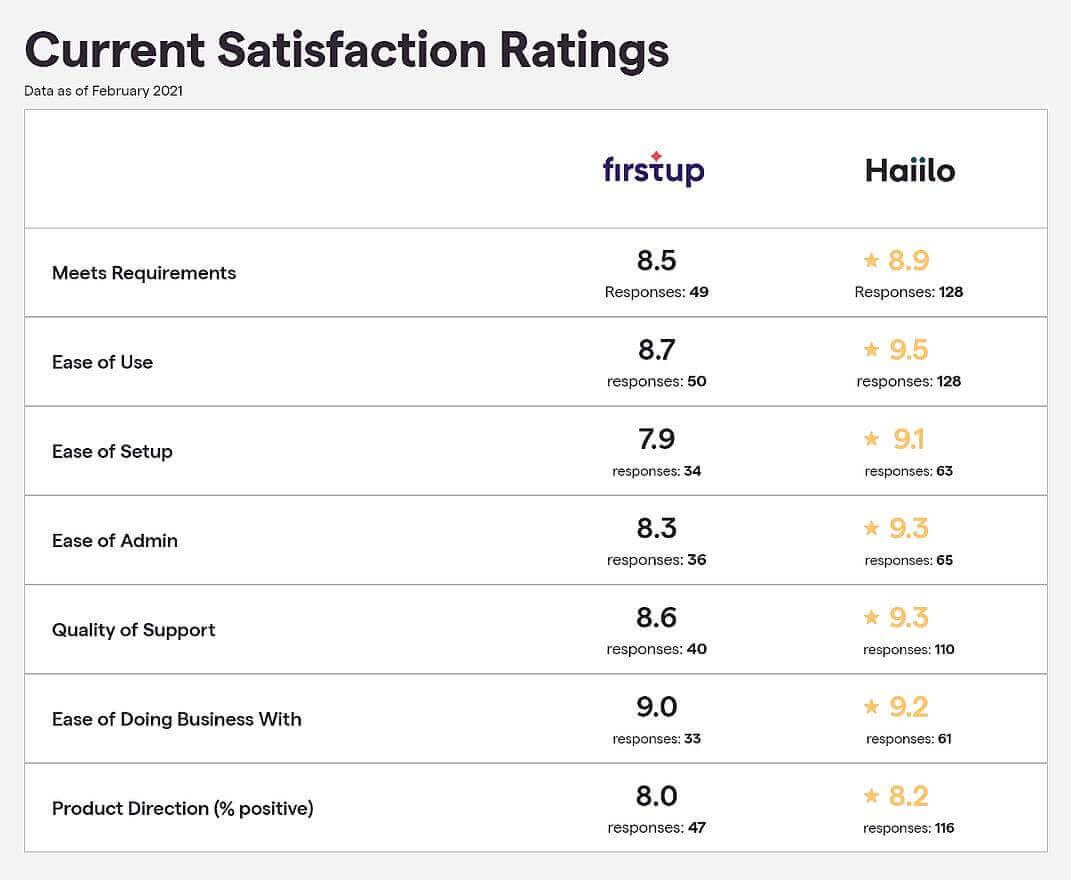Choosing the right set of internal communication tools has been one of the biggest priorities for organizations across the globe.
This blog will review the list of different types of internal communication tools that can eliminate the biggest challenges caused by inefficient communication in the workplace. We will also cover some of the biggest reasons why every organization needs IC technology. And at the end of the article, you can also find a detailed comparative analysis of some of the leading software in the internal communications category.
Book a Haiilo demo to learn how it can improve your internal communications strategy!
The Importance of Internal Communication Tools for Your Organization
The importance of IC tools can hardly be overestimated. According to Forbes, when internal communication tools are chosen wisely, they can transform company culture, create positive business outcomes and enable leaders to guide their employees. Moreover, nearly 81% of employees indicated that miscommunication occurred in their organization very frequently, frequently, or occasionally.

Some of the most important benefits of IC tools include:
- Improve employee engagement and productivity
- Boost team and cross-functional collaboration
- Improve knowledge sharing
- Decrease employee turnover
- Build trust and company culture
- Improve employees wellbeing
The Ultimate List of Internal Communication Tools
There are dozens of different communication and collaboration tools that claim to improve your employees’ productivity at work and boost virtual communication. Just keep in mind that implementing too many various solutions can have a counter effect and seriously decrease your employees’ productivity and morale.
Let’s take a look at the list of different internal communication tools to consider for your organization.
1. Instant messaging software
Instant messaging software such as Slack and Microsoft Teams are absolutely necessary for effective communication in the workplace. With the increase of remote and hybrid work, their importance became even more significant.
Today, we can almost surely claim that there is no tech company that doesn’t have instant messaging software implemented.
However, in some cases, these systems can create communication silos, where teams highly integrated into one platform cannot collaborate with departments rooted in another.
💡 If you are looking for best IM practices for your workplace, check out this great guide by Harward Business Review.
2. Social intranet
When we say intranet, many people think of old and outdated solutions that were everything but intuitive. Today, however, social intranets mimic our favorite social media platforms that we use to find relevant information and stay connected with our friends.
Social intranet serves the same purpose at work. It enables employees to easily find relevant information, collaborate on projects, create groups of people with common interests and organizational goals, and efficiently share knowledge.
💡 Also learn about how to make asynchronous communication work in your organization!
3. Employee recognition tools
We’ve already mentioned multiple times the impact employee recognition programs can have on your company culture and the business bottom line. The great news is that there are internal communication tools that help you track progress with your employee recognition incentive. Tools like Kudos or Bonusly give you an opportunity to recognize publicly the great work your employees are doing. And if you’re trying to keep your tech stack minimalist, then you can always use employee newsletters or your intranet as your employee recognition tool.
📚 Read on: Employee Recognition Program: Definition, Benefits and Ideas
4. Employee podcasts
Employee podcasts can help you to reach both desktop and deskless workers. They are great at cutting through the noise of multiple screens and notifications and might be just the right way to cater to your employees’ preferences. Consider distributing content that’s talking about company or industry news. Alternatively, you can use this internal communication tool for interviewing your employees or other subject matter experts in their field of work and increase the sense of belonging and collaboration that way.
5. Employee surveys
Employee surveys (often called employee feedback apps) are the best communication tools for enabling bottom-up employee feedback and encouraging employees’ share of voice.

What separates the best survey tools from the average ones is powerful analytics. Collecting feedback just for the sake of it means nothing if there are no insights with actionable recommendations for improvement. When automated survey analytics exist, you can easily anticipate problems and identify the best practices to support and engage your teams.
💡 Related: 16 Experts Share Their Favorite Employee Engagement Survey Questions
6. Employee collaboration and project management tools
Even though some people may not list collaboration software as a communication tool, they certainly are an important communication channel in the workplace.
Moreover, most communication tools can also be considered collaboration tools.
But software solutions such as Trello, Monday.com, or Jira are the technologies we are referring to, and they are some of the widely used workplace technologies.
7. Document sharing and management software
Document-sharing software can also be considered communication and collaboration tools. This type of communication mostly happens through comments within Word Documents, Excel spreadsheets, Google Docs, Slides, Sheets, or similar.
Furthermore, fully-featured intranets also have document storing and sharing capabilities and serve as a central repository of all important company information.
8. CEO/Leadership blog
CEO blog has the potential to become one of the most crucial tools at distributing top-down communication. It can also be helpful in breaching the gap between the C-level and employees, which in turn, improves transparency and increases trust within the company.
More than 75% of employees don’t trust their bosses who fail to share company data. These numbers then translate into disengagement, high turnover rates and, ultimately, affect the bottom line. The CEO blog might be a great internal communication tool to tackle this problem. By sharing information openly, leaders can win back the trust of their employees.
Luckily, to implement this tool, you won’t even need a separate software. A dedicated page on your company intranet will work just fine as an CEO blog.

9. Employee experience tools
Employee experience tools can help you embrace and improve your internal culture. The best part about employee experiene tools is that they’re designed to fit your specific internal comms and productivity needs. Whether you want your employees to track their shift, access a knowledge hub or have an opportunity to collaborate with their peers, this internal communication tool can be customized to your needs.
🧑🏽💻 Read more about an employee experience platforms and how to choose one.
10. Video conferencing
Video conferencing solutions have become a must for most organizations since the start of the pandemic (30% of global companies started using video conferencing for the first time during COVID-19). Google Hangouts, Zoom, GoToMeeting, Jitsi, and similar tools fall under this category.
11. Employee newsletter
An internal employee newsletter is a great way to inform and engage your employees. Every organization should consider having a monthly or weekly internal newsletter with the most important information every employee should be aware of.
Regarding newsletter tools, there are some marketing solutions such as Mailchimp and HubSpot. However, in the IC world, employee newsletters are usually available within a more comprehensive internal communication platform.
12. Employee advocacy software
Employee advocacy solutions enable employees to share company information with their own networks to improve the company’s reach, brand awareness, and sales. We included employee advocacy solutions under this list for multiple reasons:
- They should have a central, easily searchable place with information that is relevant to employees
- They should have features to easily distribute company content to multiple internal communication channels and reach every employee
- They should enable employees to share company content on their own social profiles with a few clicks.
💡 Looking to expand your workplace tech stack? Learn about why every company needs an employee app and an employee engagement software!

13. Planning tools
You might be wondering how planning tools ended up on the list of the best internal communication tools. Yet their main purpose is to help you organize your workflow. It all starts with planning, and a planning tool or an internal communications calendar is a great way to spread out content and allocate enough time for each content piece. To organize your workload nicely, you can consider tools, such as Asana, Google calendars, or even Excel. Using a native calendar in your internal communication platform can become a good planning tool as well.
14. Knowledge management hub
McKinsey Global Institute found that employees spend nearly 20% of their workweek looking for internal information or tracking down colleagues who can help with specific tasks. Another research shows that over 29% of employees say poor internal communication is the main reason projects fail.
By implementing knowledge management software as one of your internal communication tools, you can greatly reduce the time spent on looking for the right information. Tools like Google Workspace and Sharepoint are known for their knowldge storing capabilities. Alternatively, you can use your intranet of chocie to act as a knowldge hub.
15. Analytics
Analytics are still a tricky topic when it comes to internal comms. While most of the internal comms professionals agree on the importance of measuring the outcome of their campaigns, 60% are still not following up on that statement.
Analytics fit in nicely with your other internal communication tools as they provide you with granular insights on the performance of your content and, through that, help you improve your campaigns.

Advanced employee communication platforms make it possible to tie internal communication initiatives to the ultimate business goals and understand the impact of internal communication on business success.
How to Choose the Best Internal Communication Tool
In the previous section, we have listed multiple types of internal communication solutions a workplace can have. Now, we will dig deeper into how to choose the right solution.
1. Features and functionalities
Different internal communication tools can have very different features and functionalities. When reviewing those, consider software with a more comprehensive list of functionalities.
Also, think of things you may need in the future as well. For example, even though you may not need advanced analytics for your internal communications campaigns just yet, this is probably something you will want to have in the future. Keep in mind that many (if not all) workplace communication tools work on a recurrent billing basis, so you’ll have to think of the changes you’d like to make to your subscription plan well in advance.
So look for a solution that can help you track your communications KPIs and align them with your biggest business goals such as employee engagement and productivity.
2. Ease of use (user-friendliness)
User-friendliness is critical for user adoption. Unfortunately, many workplace technologies are still outdated, unintuitive, and not suitable for multigenerational workplaces.
In his study, Josh Bersin found that while 59% of companies expected their new workplace platform to be easier to use, only 35% actually achieved that benefit.

Also, the solution you choose should be mobile-first so that frontline workers without a designated working space are never left out.
3. Integrations
Having integrated workplace technology is one of the main priorities for CIOs and other IT professionals managing the communication and security aspects of the business.
In his annual report, Josh Bersin, the world’s well-known HR tech analyst, predicted that:
“the industry’s emphasis this year will be on improving the employee experience through apps that are easy to use and integrate with existing tools. This “EX layer” includes communications, surveys, case and knowledge management…”
Integrations are critical here!
When choosing an internal communication tool for your company, make sure that it easily integrates with crucial applications of your digital workplace or enables you to build your very own custom plug-ins by leveraging APIs.
If you are using Microsoft 365 or Google Workspaces, make sure that your internal communications platform integrates well with them.
4. White labeling
The look and feel of your internal communication tool should follow your company’s brand guidelines and corporate values.
When choosing an IC tool for your company, look for a solution that offers white labeling.
5. Security and compliance
Security and compliance are growing challenges for many internal communications professionals. Your employee communication software should at least be ISO27001-certified and GDPR-compliant.
You, as the buyer, should be the data controller within the meaning of the GDPR and decide on the purpose and means of this data.
6. Future product directions
Trends in the internal communications space are ever-changing. The demand for employee communications technology has been growing rapidly, and it continues to grow. More and more, workplace technology has started to look like tools we got used to using in our private lives. People expect more personalization and bigger convenience than ever before.
So when evaluating internal communication tools, make sure that you consider and investigate the company’s future product roadmap. Look for an innovative organization with a forward-looking mindset and vision.
Top 5 Solutions In the Internal Communications Software Category
If you are in the phase of evaluating or choosing the right IC tool for your company, we can make your life easier.
Recently, we did a detailed analysis of the 5 most prominent players in the internal communications app market. In this analysis, we used G2’s criteria for ranking internal communications tools. Here is an example:

The article offers a comprehensive review of some of the leading players in the internal communications app market:
- Haiilo
- Firstup
- Staffbase
- Beekeeper
- Poppulo
In this article, you will also see a detailed explanation of this software category and why solutions such as Teams, Slack, Sharepoint, and others may not necessarily fall under this category.
If you are looking for a powerful solution to improve your internal communication efforts and boost your employees’engagement at work, schedule a Haiilo demo today!









